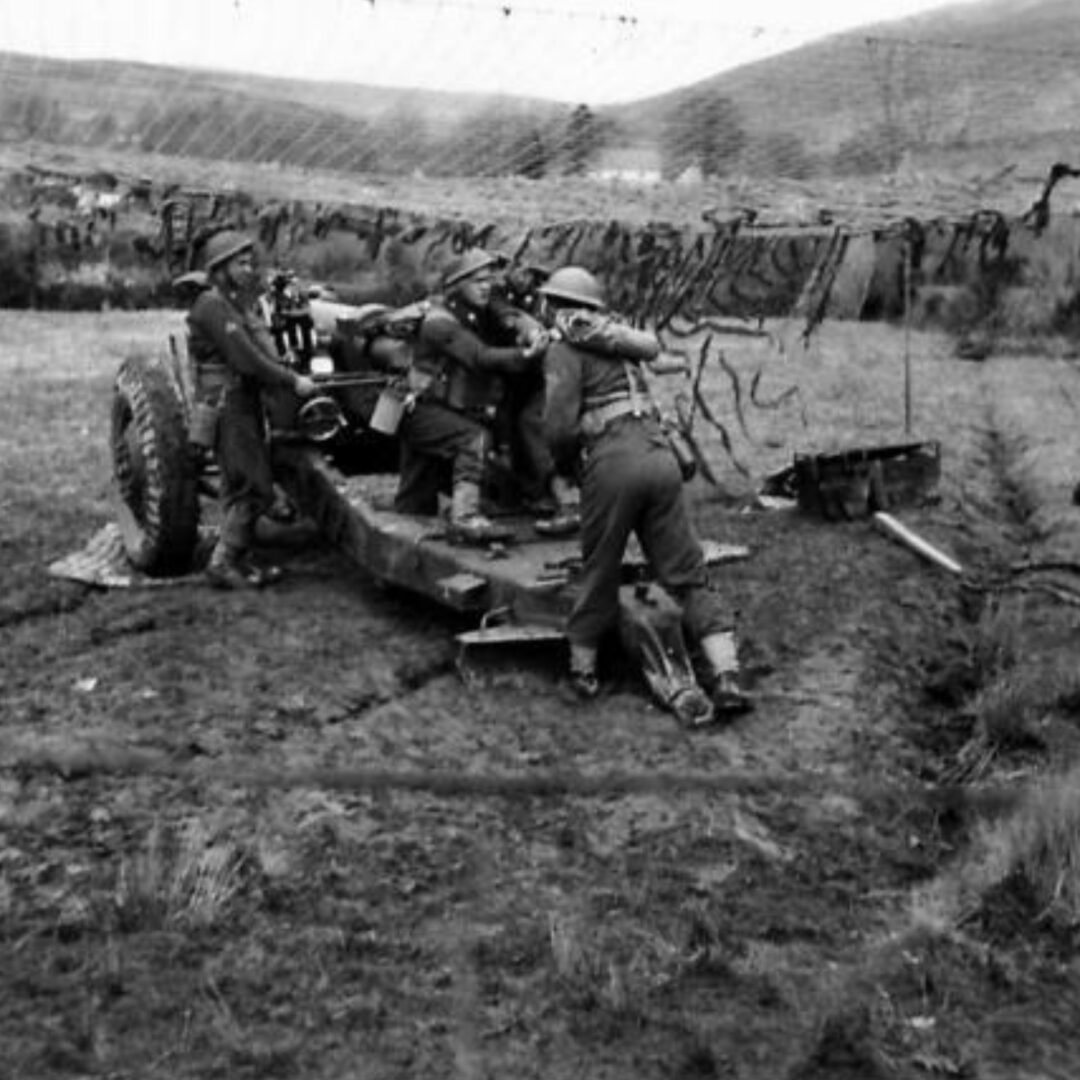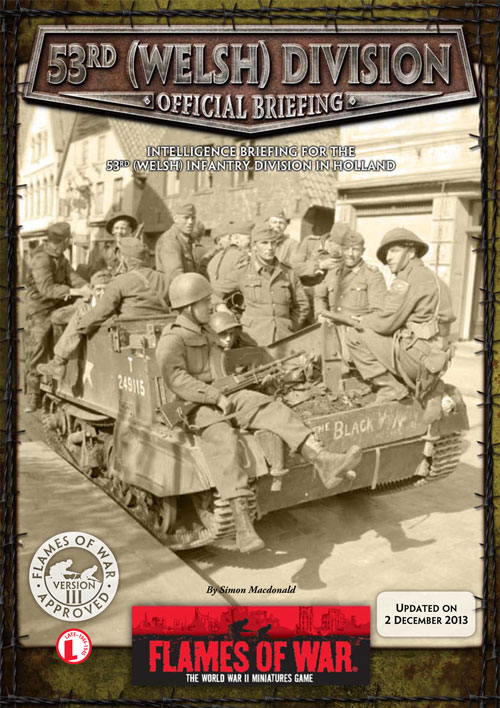
53rd (Welsh) Infantry Division WartimeNI
The 53rd (Welsh) Infantry Division landed in Normandy on 28 June 1944 and fought as part of the 2nd Army for the rest of the conflict. During this period of operations, the divisional signals laid 7,347 miles of cable; and despatch riders covered 47,511 miles; telephone calls averaged 6,773 per week (40 per hour), and the switchboard operated.

British soldier of the 53rd (Welsh) Infantry Division using a swastika
Germany Invades Poland 53 rd Welsh Division mobilised BBC Broadcasting House London 3u003csupu003erdu003c/supu003e September 1939u003cbru003e (11:15 am GMT) Start of Word War II The English Prime Minister Neville Chamberlain declares war on Germany via the BBC Home Service South Wales By 6u003csupu003ethu003c/supu003e September 1939

Pousse Plomb 53rd (Welsh) Infantry Division
The 53rd (Welsh) Infantry Division was an infantry division of the British Army that fought in both the First and Second World Wars.Originally raised in 1908 as the Welsh Division, part of the Territorial Force (TF), the division saw service in First World War, being designated 53rd (Welsh) Division in mid-1915, and fought in the Gallipoli Campaign and in the Middle East.

British 53rd Welsh Division Churchill AVRE in Geffen, the Netherlands
Operation 'ALAN' tasked the 53rd 'Welsh' and the 7th Armoured Divisions with clearing the city of S'Hertogenbosch - henceforth referred to as 'Den Bosch' - a medieval fortress city of roughly 50,000 inhabitants intersected by canals, rivers and waterways.

THE 53RD (WELSH) DIVISION CYCLIST COMPANY IN EGYPT & PALESTINE 1916
The British 53rd (Welsh) Infantry Division was a Territorial Army division that fought in both World Wars. During the First World War the division fought at Gallipoli and in the Middle East. Remaining active during the interwar years as a peace-time formation, the division again saw action in the Second World War, fighting in North-West Europe. It was temporarily disbanded at the end of the.

Soldiers from 53rd (Welsh) Division advancing through Normandy in 1944
John Curtis coach J.T. Curtis became the nation's second coach to crack the 600 wins barrier a year ago and leads the pack with a record 603-75-6 as he enters his 53rd season.

badge, formation, 53rd (Welsh) Infantry Division (INS 5443)
The 53rd (Welsh) Division, mostly from mid and north Wales, saw action in the Mediterranean and Middle East. Yet, while the 38th (Welsh) Division are remembered with a sculpture of a Welsh.

53 (Welsh) Infantry Division (UK) All Listings
Red crown and dragon : 53rd Welsh Division in North-West Europe, 1944-1945 (London : Tom Donovan Publishing, 1996) 224 p. Divisional Engineers. John H. Roberts. Welsh bridges to the Elbe : the story of the Royal Engineers - 53rd (Welsh) Division, bridge builders of the Northern France and North-West Europe campaign (Oxford : Boldacre, 2000) 277 p.

53rd (Welsh) Infantry Division (UK) on the outskirts of Ochtrup,
The Welch Regiment. 2nd Bn. The Monmouthshire Regiment. Divisional Troops. 53rd Reconnaissance Regiment, Royal Armoured Corps. 1st Bn. The Manchester Regiment. 81st (Welsh) Field Regiment, Royal Artillery. 83rd (Welsh) Field Regiment, Royal Artillery. 133rd (Welsh) Field Regiment, Royal Artillery. 71st Anti-Tank Regiment, Royal Artillery.

53rd (Welsh) Division. British Friends of Normandy
The 53rd (Welsh) Infantry Division was an infantry division of the British Army that fought in both World War I and World War II.Originally raised in 1908 as the Welsh Division, part of the Territorial Force, the division saw service in World War I, being designated 53rd (Welsh) Division in 1915, and fought at Gallipoli and in the Middle East.Remaining active in the Territorial Army during the.

53rd (Welsh) Infantry Division (UK) attack west of Oss
1st Bn. The Manchester Regiment (6) Headquarters, 53rd (Welsh) Divisional Royal Artillery 81st (Welsh) Field Regiment, Royal Artillery 83rd (Welsh) Field Regiment, Royal Artillery 133rd (Welsh) Field Regiment, Royal Artillery 71st Anti-Tank Regiment, Royal Artillery (7) 116th Light Anti-Aircraft Regiment, Royal Artillery (8)

Infantry and universal carriers of 53rd (Welsh) Division passing
53rd (Welsh) Division in the Second World War 1939-1945 - The Wartime Memories Project - - 53rd (Welsh) Division during the Second World War - Allied Forces Index If you enjoy this site please consider making a donation. Site Home WW2 Home Add Stories WW2 Search Library Help & FAQs WW2 Features Airfields Allied Army Allied Air Forces Allied Navy

53 (Welsh) Infantry Division (UK) All Listings
The 53rd (Welsh) Infantry Division was an infantry division of the British Army that fought in both the First and Second World Wars.

53rd (Welsh) Infantry Division (UK) in Alpen
Monty's plan to blast his way through the Reichswald was delayed, first by the necessity of opening Antwerp and the Scheldt Estuary to seaborne traffic, then by the Battle of the Bulge, which temporarily took 30th Corps away from the Reichs-wald to backstop the Americans on the Meuse River.

St David's Day, Tenglemans Factory, West Germany 1946. 6 RWF, 53rd
53rd (Welsh) Infantry Division. Order of battle - June 1944 - Battle of Normandy. Commander: Major General R. K. Ross. 71st Infantry Brigade: Brigadier V. Blomfield - 1st Battalion, East Lancashire Regiment. - 53rd Regiment, Reconnaissance Corps. Artillery - 81st Field Regiment, Royal Artillery

THE 53RD (WELSH) DIVISION CYCLIST COMPANY IN EGYPT & PALESTINE 1916
Second World War 1939 The Territorial Army and the 53rd (Welsh) Division, commanded by Major-General Bevil Wilson [9] serving under Western Command, was mobilised on 1 September 1939, [10] the day the German Army invaded Poland, and two days later the Second World War officially began.